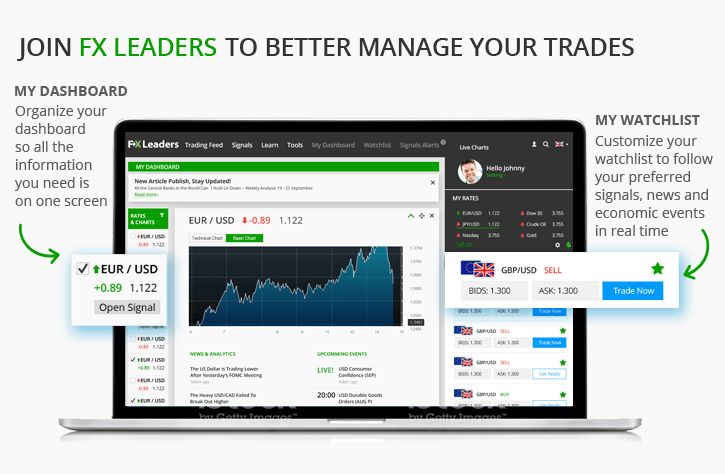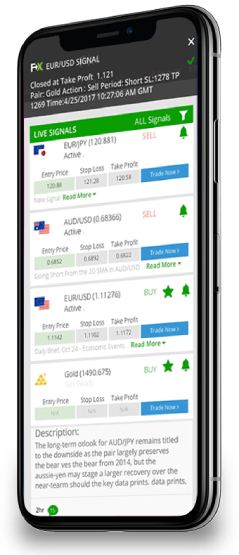Last Update: July 27th, 2024
Cryptocurrencies are being traded more frequently than ever before, which is why
it is so important that investors make use of free crypto signals. These are tools
created by industry experts to alert investors about promising trading opportunities.
With the massive trade volumes the cryptocurrency market is seeing, free crypto signals
have become an invaluable buying and selling tool. They help you to sort through the
hundreds of digital assets and the overwhelming data to make sense of it all.
How to use Crypto Signals?
Forex signals are trade recommendations, generated either manually by trading experts, or automatically by trading algorithms. Trading signals include the asset to be traded, the entry level, and the stop loss and take profit levels. Crypto trading signals are the same as forex signals, and traders can follow them either manually, or automatically through copy trading. The entry price can fluctuate considerably in the crypto market, since this is a very volatile market, which means that traders should open their trades at the best possible price.
How to Use Crypto Trading Signals
Types of Crypto Signals
Crypto trading signals can enhance a traders performance, but there are various different types, and traders should know which one to pick according to their needs. Crypto signals can be manual, automatic, long-term or short-term, etc.
Manual Crypto Signals
These types of signals are generated manually by experienced traders, who base their trade recommendations on technical and fundamental factors. Manual signals also take the market sentiment into consideration. Fxleaders signals are opened manually, with the stop loss and take profit targets provided.
Automatic Crypto Signals
Automatic signals are generated by trading algorithms. They are based on technical strategies in general, which are backtested in advance. However, these crypto signals lack flexibility when market conditions change, and in the crypto market the situation changes pretty fast, according to the sentiment.
Automated vs Manual Crypto Signals
Short-Term Crypto Signals
These signals take advantage of daily and weekly swings in the crypto market, targeting gains of 20% to 100%, since this is a normal range in this market. Short-term crypto signals keep the risk limited and are generated with stop loss and take profit targets.
Long-Term Crypto Signals
Long-term crypto signals can last for months, and they are usually generated manually. They try to catch several waves of the larger trend in the crypto market and are usually buy signals, since the long-term trend in cryptocurrencies is bullish. Such signals target profits of up to 1,000%, considering the large gains in the market.
Entry/Exit Crypto Signals
Such signals are usually mid-term, and they try to make the most of a bullish wave. When the sentiment improves in the market and technical indicators indicate a buying opportunity, an entry signal is generated, with an open take profit. When a trend has run its course, the pressure starts to fade and indicators begin signaling a reversal, an exit signal is issued, which is your sign to close the trade.
Action Forex Signals
These signal types are generated once the trend has started. They use the price action, which indicates a bullish or bearish momentum, as a strategy. They tend to be short-term signals, with a smaller earning potential, but with higher odds of hitting take profit.
Using Telegram for Crypto Signals
Telegram has become a very popular channel for forex signals, and now for crypto signals as well. They have introduced the Telegram.forex site, where users can follow successful traders into their MT4 platforms through the trade copier. However, while there are many professional traders, there are also growing numbers of Telegram crypto signals services that are scams. There are different types of scams, such as fixing profits, manipulating prices, not delivering on signals and performance, or simply stealing your account. As a trader, you should be aware of private messages that require account information, and you should also test-check the signal providers, in order to filter out the majority of Telegram scammers.
Bitcoin (BTC) Trading Signals
Bitcoin heralded in the birth of the crypto market in 2009, and it is still the leading cryptocurrency, with more than 40% market domination. Bitcoin transactions are verified by a computing process known as "mining." Bitcoin signals have become very common, as the earning potential has increased immensely, along with the volatility, since 2020. With high volatility comes high risk too, which means that it is best to follow BTC signals with no leverage at all.
Altcoin Trading Signals
Altcoin signals have been on the rise with the increasing number of digital tokens. Crypto signal providers offer signals on a variety of altcoins, although not all signals are suitable for all traders. The volatility in some cryptocurrencies could be extreme - even higher than Bitcoin - so such altcoin signals should be avoided by traders with low liquidity.
Ethereum (ETH) Trading Signals
Ethereum, which is a decentralized open-source platform for smart contracts, was the first blockchain with actual use cases. It includes over 3,000 DApps, which utilize the native token Ether, making it the second most important altcoin. Ethereum is upgrading from power of work (PoW) to power of stake (PoS), which should make gas fees cheaper and encourage major projects to keep building on the Ethereum network, alongside the current ones, such as MakerDao, Axie Infinity etc. Ethereum signals tend to be less risky, since Ethereum is now considered the average indicator of the crypto market.
Cardano (ADA) Trading Signals
Cardano is a proof-of-stake blockchain platform with the native token ADA, whose holders have the right to vote on any proposed changes to the software. With the Alonzo hard fork, which was launched in September 2021, Cardano opened the door for real use cases, such as smart contracts. Cardano has been less volatile than the crypto market average, which means smaller targets for Cardano signals. The main Cardano signals to follow are ADA/USD and ADA/USDT.
Shiba Inu (SHIB) Trading Signals
This meme coin, which is a newcomer to the industry, was started as a response to Dogecoin. It has attracted a lot of users, and has become the most popular cryptocurrency in terms of followers. Spikes have been few and far between, which means that Shib signals are usually long-term, on a buy-and-forget strategy, with low risk and high earning potential.
Solana (SOL) Trading Signals
Solana is a fully functional Layer 1 blockchain, with the emphasis on smart contracts, which account for more than 500 that are built on its network. Solana has reached a transaction throughput of 50,000 TPS, by introducing the proof of history (PoH) consensus, combined with the underlying proof-of-stake (PoS) consensus. This has kept the SOL coin in demand since it was launched; long-term Solana signals thus tend to be buy signals.
Binance (BNB) Trading Signals
Binance is one of the main global crypto exchanges and the largest in terms of trading volumes. However, it is a centralized exchange (CEX), which has made it a target during the global crypto crackdowns. It has been banned in a number of countries, but the BNB coin continues to enjoy increasing demand. BNB has been less volatile than most of the crypto market, which means that BNB signals are long term, lasting from several months to several years.
Polkadot (DOT) Trading Signals
Polkadot is an open source blockchain platform with the native token, DOT. It enables cross-blockchain transfers of cryptocurrencies, but also any type of data or digital asset. The Polkadot network could be considered a Layer 0 protocol, because it underlies a format for a network of Layer 1 blockchains, known as parachains (parallel chains). The first few parachains went live in November 2021, and more will be coming in the years ahead, which is expected to keep DOT in demand. Polkadot has displayed volatility, which means that DOT signals should have large stops to protect traders from whipsaws.
Terra Luna (LUNA) Trading Signals
Terra is a blockchain protocol operating on a proof of stake (PoS) model. Terra uses algorithms to generate stablecoins, which are cryptocurrencies that are pegged to fiat currencies to offer fast and affordable settlements. Terra has its native coin LUNA, which is used to stabilize the price of stablecoins. The growth of DeFi on the Terra network, to second place after Ethereum, has kept the LUNA coin bullish, so LUNA signals also tend to be buy trade suggestions, since this cryptocurrency was the most bullish in 2021.
Fantom (FTM) Trading Signals
Fantom considers itself a highly scalable directed acyclic graph (DAG) smart contract Layer 1 blockchain platform for decentralized finance (DeFi), crypto applications (dApps) and enterprise applications. Transactions are confirmed in one second, and they cost an average of one cent. Some of Fantom’s best dApps include AnySwap, Yearn Finance, SushiSwap and Abracadabra. Together with its native coin FTM, Fantom aims to reduce the transaction speed for smart-contract platforms. FTM has been another bullish crypto with high volatility, which means that FTM signals should be entry/exit trade signals, or ones with really large targets.
Crypto Signals Faqs
What Are Crypto Signals?
Crypto signals are trade recommendations to open a position in a cryptocurrency. Crypto signals are issued by professional traders and analysts after thorough consideration of the crypto fundamentals, tokenomics, technical analysis and broader market sentiment. Crypto signals include the name of the asset to trade, the order type to buy or sell, as well as the take profit and stop loss levels. They are displayed on the signals service page or are sent through various means, such as SMS, email, WhatsApp or other messages. Typically, crypto signals include the following information:
Name of Asset Pair to Trade (BTC/USD, BTC/ETH, ETH/USD, XRP/USD etc.) – This is the abbreviation of the cryptocurrency name which is displayed as the first asset, followed by the asset you are buying/selling against, such as the USD.
Type of Action (Buy/Sell) – This is a call-to-action-style signal in most instances, with it often taking the form of a direct “Buy” or “Sell” statement.
Targets to Close the trade (Take Profit and Stop Loss) – The Take Profit target is the exit point for a trade in case the price goes in the right direction, while the Stop Loss target is where the trade closes if the price goes in the wr0ng direction, once the price has reached that level.
Entry Price – The Entry Price in a crypto signal is the price where the cryptocurrency at the time the signal was issued. It helps followers compare the price of the crypto coin at the time when the signal was sent with the actual price at the time the follower opens the order.
Read more about
what are crypto signals?
How to Read Crypto Trading Signals?
Crypto signals are a set of information to help traders execute a trade, so they are pretty simple and easy to read, since they provide the most important information needed to trade. Pending signals instruct followers to leave a pending order, with the Entry Price, Stop Loss and Take Profit, while live signals are a call to action. All you need to do is to follow the instructions and open the trade as soon as possible once you get the signal, in order for the actual price to be as close to the entering price in the signal. Just copy the targets to your trading account and you’re set.
Read more about
how to make the most out of crypto trading signals?
How to Understand Crypto Signals?
Crypto signals are issued after considerable analysis from experienced analysts, who expect the price to go in a certain direction. They include all the important information for traders to copy, although traders are not obligated to follow the instructions exactly as received in the signal. They can move targets to maximize the profit or avoid a loss, in case the forces which drive the crypto market around change. Different signal providers also adjust the TP and SL targets when markets change as nothing is written in the stone, although follower can decide whether to implement these changes.
Read more about
how to use and understand crypto signals?
What Is A Crypto Signals Provider?
A crypto signals service provides trading instructions to open a buy/sell position on a cryptocurrency, which can be free, for a fee or mixed. Signal services employ experienced traders who understand the cryptocurrency system pretty well or an automated trading software which opens issues trade recommendations based mostly on crypto technical. FXleaders is a signal service provider, which offers crypto signals as well as trading signals on most important markets.
How to Trade Crypto Signals
Trading crypto signals is easy, all you have to do is follow the instructions as indicated in the signal. Open the trade by buying or selling the asset that is specified, as soon as receiving the alert, so the actual price will be as close as possible to the opening price of the signal. Place the stop loss and take profit target to protect the trade and book profit in case the price goes in the right direction and the trade will close automatically. Traders who are more experienced in the cryptocurrency market can also play with stop loss and take profit targets to avoid losses or maximize profits.
Read more about
crypto signals for technical traders
What Is the Best Crypto Signal Provider?
The performance and returns of the signals decide the best signal provider, so profit history shows a lot, although the provider should be tested in real time as well, with real money. The win/loss ratio over a period of time shows the performance in simple terms, but the stop loss and take profit targets also matter, so they should be taken into consideration when evaluating the win/loss ratio. The frequency of crypto signals and the exposure (number of signals open) is another factor which each trader should take into consideration according to the equity and their trading strategy.
Are Crypto Signals Legit?
As a trader, do take when choosing a crypto signal provider and perform due diligence before subscribing to a crypto signals service. Take some time to test the service by following each trade for a period of time, copying them on a demo account or by adding signals to your own market analysis toolkit to assess the performance. As long as crypto signal providers offer trade recommendations, they are legit, but their acclaimed performance might not be too legit. Usually, the more transparent a signals service is, the more legit their work is.
 GET ALERTS
GET ALERTS















